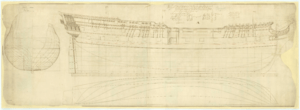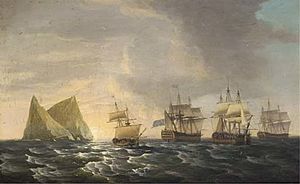HMS St Albans (1764) facts for kids

St Albans
|
|
Quick facts for kids History |
|
|---|---|
| Name | HMS St Albans |
| Ordered | 13 January 1761 |
| Builder | Perry, Blackwall Yard |
| Launched | 12 September 1764 |
| Fate | Broken up, 1814 |
| Notes | Floating battery from 1813 |
| General characteristics | |
| Class and type | St Albans-class ship of the line |
| Tons burthen | 1380 (bm) |
| Length | 159 ft (48 m) (gundeck) |
| Beam | 44 ft 4 in (13.51 m) |
| Depth of hold | 18 ft 10 in (5.74 m) |
| Propulsion | Sails |
| Sail plan | Full-rigged ship |
| Armament |
|
HMS St Albans was a powerful British warship from a long time ago. It was a "ship of the line," which means it was one of the biggest and strongest ships in the Royal Navy. Launched in 1764, this ship had 64 guns and played a big part in important wars, especially the American War of Independence. It was built to be a strong fighter on the seas.
Contents
About HMS St Albans
HMS St Albans was a 64-gun ship. This means it carried 64 cannons! It was a "third-rate" ship, which was a very common type of warship in the Royal Navy. It was built in London by Perry, Wells & Green and launched on September 12, 1764.
The ship was about 48.5 meters (159 feet) long on its main gun deck. It weighed around 1,380 tons. St Albans had 64 guns in total. These included 26 heavy 24-pounder guns on the lower deck and 26 lighter 18-pounder guns on the upper deck. It also had smaller guns on the quarterdeck and forecastle.
This type of 64-gun ship was the second largest class of warships in the navy. They were like a more affordable version of the bigger 74-gun ships. While they didn't have as much firepower or speed as the 74-gun ships, they were cheaper to build. This meant the navy could have more ships for their money.
Life at Sea: The Ship's Crew
HMS St Albans needed a large crew to operate. It sailed with about 525 men. These sailors and officers worked together to sail the ship, fire the guns, and keep everything running smoothly. Life on a warship like St Albans was tough, but these crews were very skilled.
Important Battles and Service
HMS St Albans saw a lot of action during its time. It served in the American War of Independence, which was a big conflict between Great Britain and the American colonies.
Early Service and the American War
In 1776, Captain Richard Onslow took command of St Albans. He sailed the ship to New York City in 1777. There, it joined a fleet led by Lord Howe. St Albans helped to defend against a French attack at Sandy Hook in July 1777.
The ship also captured several enemy ships in 1777 and 1778. In November 1778, St Albans sailed to the West Indies. It took part in the capture of Saint Lucia and helped defend it from French forces.
Action in the West Indies
In 1780, Captain Charles Inglis became the commander of St Albans. In 1781, the ship sailed with a fleet to help the British forces at Gibraltar. Later that year, St Albans joined Sir Samuel Hood's fleet in the Leeward Islands.
St Albans was with Hood during the Battle of Saint Kitts in January 1782. In this battle, the British fleet fought off several attacks by a French fleet led by the Comte de Grasse.
The ship also fought in the Battle of the Saintes on April 12, 1782. This was a very important battle where the British fleet, led by Admiral Sir George Rodney, decisively defeated the French. St Albans had six sailors wounded during this big fight.
Later Encounters
In 1783, St Albans was part of a squadron looking for French ships near Martinique. On February 15, 1783, a British ship, HMS Magnificent, chased and captured a French frigate called Concorde. St Albans and another ship, Prudent, arrived later to help.
In 1794, St Albans helped rescue the crew of another British ship, HMS Actif, which was sinking. The ship also helped capture an enemy brig named Molly in 1808.
Final Years
In 1810, St Albans served in China under Captain Francis Austen. Later that year, it was refitted in Chatham. From 1810 to 1812, it was stationed at Cadiz under different captains.
Fate of the Ship
By September 1813, HMS St Albans was no longer used as a regular warship. It was converted into a "floating battery." This meant it was used as a platform for guns, often in a harbor, rather than sailing the seas. The ship was finally broken up in June 1814, ending its long and active service.


